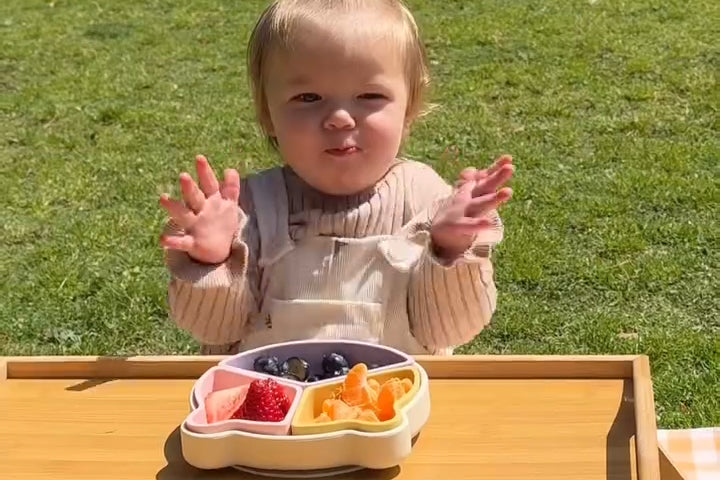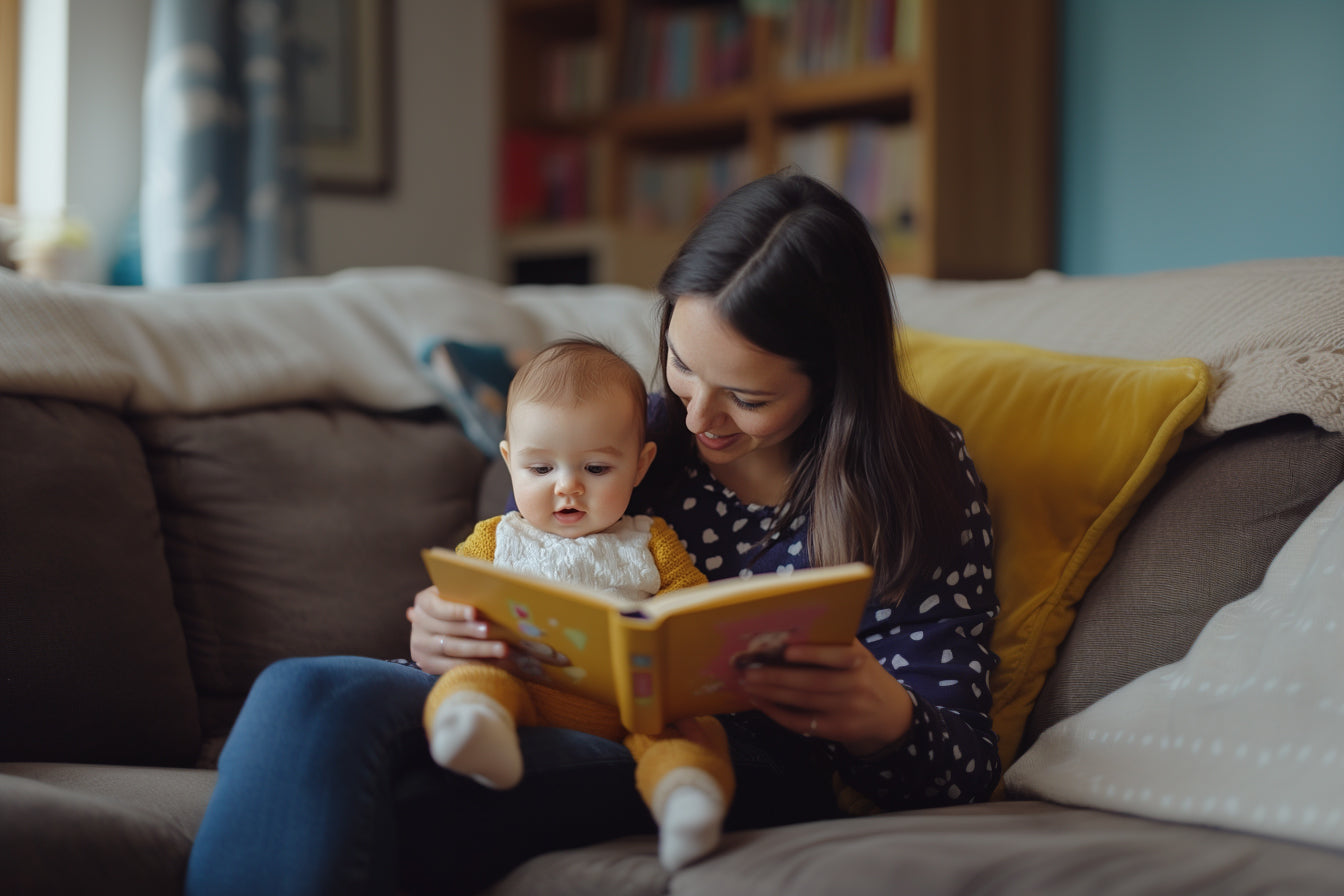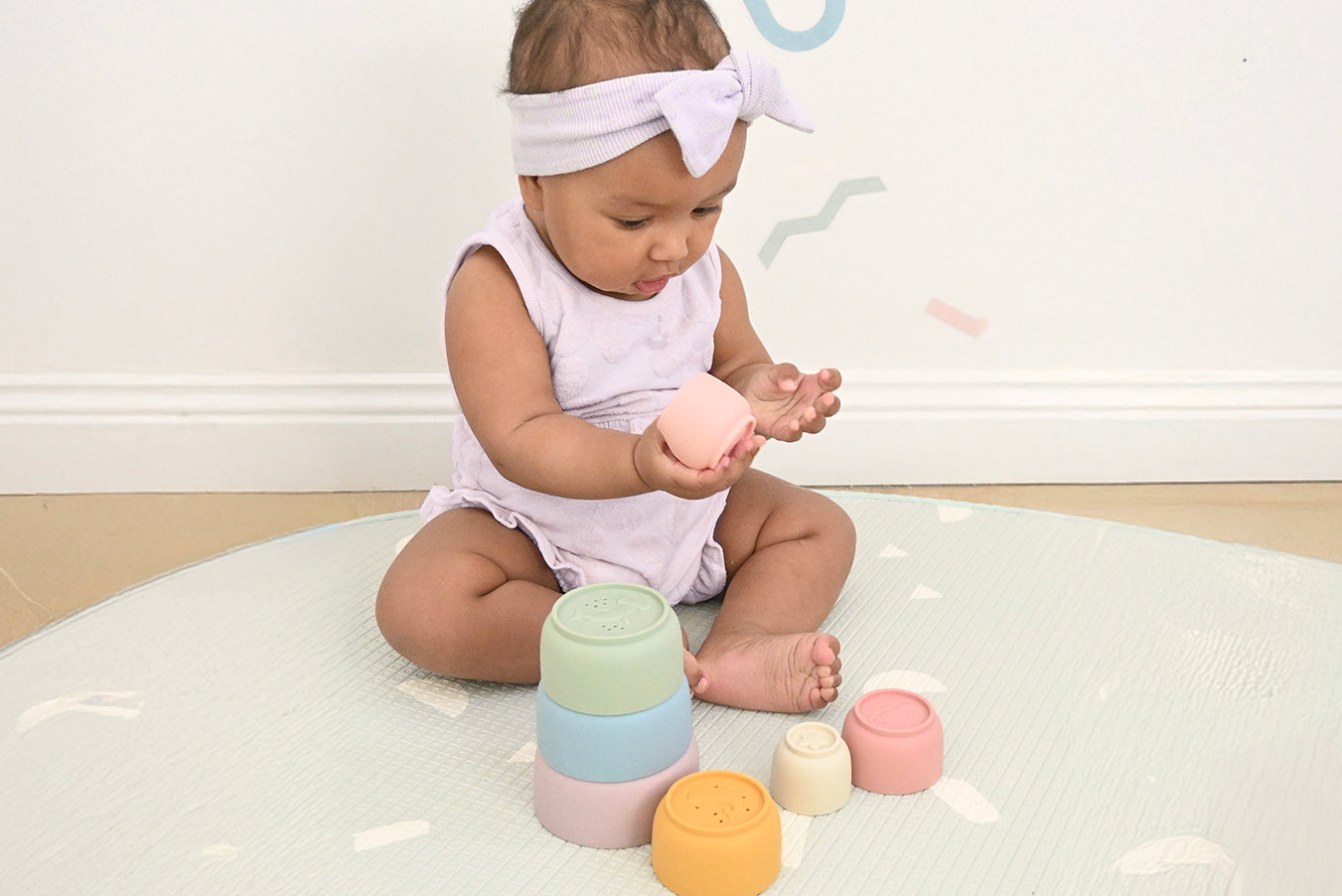Blog Posts

The Best Toy for Cause & Effect Learning
by Mark Laurence Mario on Sep 05, 2025
Introduction
In early childhood, every curious action is part of a bigger lesson. One of the most important skills toddlers develop is cause and effect—understanding that their actions lead to predictable outcomes. From pressing a button to see a toy light up, to dropping food and watching it fall, children are constantly testing this concept.
If you’re wondering what toy best supports cause-and-effect learning, one stands out among the rest: the Drop & Roll Tower. In this article, we’ll explore why this toy is considered one of the best educational toys for toddlers, the science behind cause-and-effect play, and how parents can maximize its benefits.
What Is Cause-and-Effect Learning?
Cause and effect is the understanding that one action creates a result. Babies begin to grasp this concept as early as 2–4 months old, and it plays a critical role in early brain development.
Why it matters:
Cognitive growth: Builds logical thinking and problem-solving skills.
Motor skills: Strengthens coordination through repeated actions.
Language development: Helps connect words with experiences.
Social development: Supports turn-taking and observing peer reactions.
This makes cause-and-effect toys some of the most valuable additions to a child’s playroom.
Why Choose the Drop & Roll Tower?
The Drop & Roll Tower toy is specifically designed to make cause-and-effect learning clear, engaging, and fun. Unlike overly complicated toys, it focuses on simplicity and repetition, which are key for toddlers’ understanding.
Key Features That Make It the Best Toy for Cause and Effect
Clear Action-to-Outcome Connection – Dropping the ball instantly leads to it rolling down. Toddlers immediately see their action creating a result.
Endless Repetition – Kids love repeating the process, which strengthens learning and memory.
Multi-Sensory Play – Watching the ball spiral, hearing it land, and feeling the drop engages multiple senses.
Supports Motor Skills – Improves fine motor skills (grasping and dropping) and gross motor skills (chasing after the ball).
Encourages Social Interaction – Perfect for turn-taking with siblings or friends, teaching patience and sharing.
Expert Backing: What Child Development Specialists Say
According to the American Academy of Pediatrics (AAP), the best toys are those that encourage active play, problem-solving, and imagination—not just passive entertainment.
Child psychologist Dr. Laura Markham emphasizes:
“Toys that clearly demonstrate cause and effect, like drop-and-roll mechanisms, give children the building blocks of scientific thinking.”
The Drop & Roll Tower perfectly fits this principle, offering clarity, simplicity, and endless opportunities for exploration.
Beyond Cause and Effect: Other Benefits of the Drop & Roll Tower
While the toy’s main appeal is cause-and-effect learning, it supports other developmental areas as well:
Hand-Eye Coordination: Aligning the ball with the opening.
Problem-Solving Skills: Asking “What happens if I drop two balls?”
Language Development: Parents can introduce phrases like “Drop,” “Roll,” and “Down.”
Attention & Focus: Waiting for the ball to finish rolling builds patience.
This makes the Drop & Roll Tower a multi-purpose learning toy that grows with your child.
How Parents Can Enhance Learning Through Play
To maximize the developmental value of the Drop & Roll Tower, try these strategies:
Narrate the Play: Use descriptive words—“The ball rolls down!”—to build vocabulary.
Encourage Predictions: Ask, “Where will the ball go?” before dropping it.
Play Together: Model turn-taking to build social skills.
Experiment with Variations: Use different colors or textures of balls for comparison.
Connect to Real Life: Point out everyday cause-and-effect examples like flipping a switch or pouring water.
Safety and Quality: A Parent’s Top Priority
The Drop & Roll Tower is designed with child-safe materials and rounded edges, ensuring it’s as safe as it is fun. Its durable build withstands repeated play, and the ball size prevents choking hazards, giving parents peace of mind.
Why Parents Love the Drop & Roll Tower
Parents often praise how much their children return to this toy day after day. Unlike flashy toys that lose interest quickly, the Drop & Roll Tower stays engaging thanks to its open-ended, repeatable play. Parents also appreciate that it’s not just a source of fun—it’s an educational investment in their child’s development.
Conclusion
When it comes to toys that teach cause and effect, the Drop & Roll Tower stands out as a clear winner. It offers toddlers a hands-on way to explore how actions create results, all while supporting fine motor skills, problem-solving, and social play.
For parents seeking a toy that balances fun with genuine developmental value, the Drop & Roll Tower is more than just playtime—it’s an opportunity for growth.
✨ Give your child the joy of discovery and the power of learning through play with the Drop & Roll Tower—the best toy for cause-and-effect learning.

How to Serve Hydrating Foods to Babies and Toddlers
by Natalie Cacace on Jul 11, 2025
Proper hydration is essential for babies and toddlers, especially during warmer months, when activity levels increase, or if your child is unwell. While fluids like breast milk, formula, and water are the primary sources of hydration, many parents don’t realize that solid foods can also play a powerful role in supporting hydration. This article explores how to incorporate hydrating foods into your baby or toddler’s diet in a safe, practical, and nutritious way.
Why Hydration Matters in Early Childhood
Hydration affects nearly every system in a child’s body — from digestion and temperature regulation to brain development and physical energy. Dehydration in young children can occur more quickly than in adults, due to their smaller body size and higher surface area-to-volume ratio. Mild dehydration can lead to fatigue, irritability, and constipation, while more serious cases may require medical attention.
That’s why offering water-rich foods, in addition to regular fluids, is a proactive way to support your child’s daily hydration needs.
When Can Babies Start Eating Hydrating Foods?
Babies can typically begin eating solids around 6 months of age. At this stage, breast milk or formula remains the primary source of hydration and nutrition, but complementary foods can gradually introduce new textures, flavors, and nutrients — including water-rich foods.
Always consult your pediatrician before introducing new foods, especially if your child has food allergies or medical conditions.
Best Hydrating Foods for Babies and Toddlers
These foods are naturally high in water content and safe for young children when prepared appropriately:
1. Cucumber (96% water)
Serving idea: Peel and finely grate or steam for younger babies; offer thin strips for toddlers.
Benefits: Low in calories, rich in vitamin K, and very hydrating.
2. Watermelon (92% water)
Serving idea: Mash for babies; cut into soft cubes or use melon ballers for toddlers.
Benefits: High in vitamin C and antioxidants, perfect for hot days.
3. Zucchini (95% water)
Serving idea: Steam and mash or spiralize for sensory exploration.
Benefits: Mild flavor and soft texture make it ideal for first foods.
4. Strawberries (91% water)
Serving idea: Mash or puree for babies; offer diced for toddlers.
Benefits: Packed with vitamin C and fiber, great for immunity and digestion.
5. Oranges (86% water)
Serving idea: Juice segments for babies (strained to avoid pulp); offer seedless pieces to older toddlers.
Note: Introduce citrus gradually and watch for reactions.
6. Yogurt (approx. 85% water)
Serving idea: Plain, whole milk yogurt is ideal for babies over 6 months.
Benefits: Contains water, protein, calcium, and beneficial probiotics.
7. Broth-Based Soups
Serving idea: Blend into smooth purées or offer spoonfuls to toddlers with a soft, wide spoon.
Tip: Choose low-sodium, homemade broths when possible.
Tips for Serving Hydrating Foods Safely
Watch for choking hazards. Cut soft fruits and vegetables into age-appropriate sizes.
Use suction plates or divided trays to reduce mess and encourage self-feeding.
Offer a variety of textures: steamed, mashed, or raw (for older toddlers).
Don’t forget fluids: water-rich foods complement — not replace — breast milk, formula, or water.
Signs Your Baby or Toddler May Need More Fluids
Even with a water-rich diet, it’s important to be alert to signs of dehydration, including:
Fewer wet diapers than usual
Dark or strong-smelling urine
Dry lips or mouth
Fatigue or unusual fussiness
If you notice any of these symptoms, consult your pediatrician promptly.
Final Thoughts
Hydrating foods offer a simple yet powerful way to support your baby or toddler’s fluid intake while introducing nutrient-dense options. With the right preparation and variety, you can make hydration not only effective — but fun and delicious.
By building these habits early, you're setting the stage for a lifetime of healthy hydration.

How to Optimize Your Baby’s Nursery for Better Sleep
by Natalie Cacace on Jun 29, 2025
Sleep is one of the most essential parts of a baby’s development—and one of the most challenging aspects of parenting. While routines and schedules matter, the nursery environment plays a powerful role in how well your baby sleeps.
In this blog, we’ll walk you through simple and effective ways to create a sleep-friendly nursery that promotes longer, safer, and more restful sleep.
1. Keep It Dark
Babies sleep best in a dark room. Darkness encourages melatonin production, the hormone that signals it's time to sleep.
Install blackout curtains to block outside light
Cover small electronic lights or use low-light baby monitors
Try a portable blackout shade when traveling
🌙 Bonus: Darkness can help extend early morning sleep or nap time when the sun’s still shining.
2. Manage the Temperature
The ideal nursery temperature is between 68°F and 72°F (20–22°C). Overheating can disrupt sleep and increase the risk of SIDS.
Use a room thermometer to monitor the temperature
Dress your baby in light layers or a breathable sleep sack
Avoid heavy blankets or stuffed toys in the crib
3. Use White Noise
White noise mimics the sounds of the womb and blocks out environmental noise. It’s especially helpful for naps and light sleepers.
Use a white noise machine or app with a soft, consistent hum
Keep volume safe and device across the room from the crib
Use the same sound every night for consistent cues
4. Choose a Safe Sleep Setup
Your baby’s crib or bassinet should follow safe sleep guidelines.
Use a firm mattress with a fitted crib sheet
No pillows, bumpers, or plush toys in the crib
Use only safety-certified cribs, bassinets, or play yards
✔️ Keep it minimal. A clutter-free crib is a safe crib.
5. Soothing Colors and Soft Lighting
Calming, muted tones create a peaceful mood and reduce stimulation.
Choose bedding, paint, and decor in gentle colors
Use dimmable nightlights or soft lamps for late-night care
Avoid bright or overly stimulating designs near the crib
6. Smart Storage & Minimal Clutter
A tidy nursery creates a calm atmosphere and makes parenting easier.
Use shelves, bins, or baskets to organize essentials
Keep nighttime supplies (diapers, wipes, pacifiers) within reach
Rotate toys regularly to maintain a calming space
7. Build Sleep Associations
The nursery should signal sleep. Use consistent, gentle routines to help your baby understand when it's time to rest.
Read a short bedtime story in the same chair each night
Use a comfort item like a lovey (for babies 12 months+)
Put your baby down drowsy but awake in the same sleep space
Final Thoughts
A well-designed nursery is more than just cute—it’s a powerful tool to help your baby (and you) get better sleep. With a dark, quiet, cozy, and safe space, your little one has the best chance at restful nights and smoother days.
Start small and adapt as you go. Every baby is different, but consistency and comfort make all the difference.

Crying Isn’t a Joke: How Laughing Hurts Kids
by Natalie Cacace on Jun 23, 2025
As parents, we want our children to feel loved, safe, and supported. But sometimes, without meaning to, we send the wrong message—especially when it comes to our child’s emotions.
One common but harmful response to a child’s crying is laughing or making light of their feelings. While it may seem like a harmless reaction or even a way to cheer them up, laughing at a child when they’re upset can do more harm than good.
In this blog, we’ll explore why crying should never be treated as a joke and how we can help our little ones feel truly seen and heard.
Crying Is a Child’s Language
Babies and toddlers don’t have the words to explain what they feel. Crying is one of the main ways they express:
Hunger or tiredness
Frustration or fear
Pain or discomfort
A need for connection or attention
When we dismiss those cries with laughter, we risk sending a message that their feelings are not valid—or even something to be ashamed of.
Why Laughing Can Hurt
Laughing at a child who is crying may:
Create confusion: They feel bad but see you smiling or giggling. This disconnect can make them question their feelings.
Build insecurity: Over time, they may stop expressing emotions, fearing they’ll be mocked or not taken seriously.
Damage trust: Children need to know they can come to us with big feelings and be met with comfort, not comedy.
🧠 Early emotional experiences shape how children understand and handle emotions for the rest of their lives.
Common Situations Where This Happens
Even well-meaning adults fall into this habit, often during:
Tantrums in public places
Frustration over “small” things (like a broken toy or dropped snack)
Videos on social media that show crying babies for laughs
While it might seem funny in the moment, especially to outsiders, for the child involved it’s a moment of deep emotional need.
How to Respond with Empathy
Instead of laughing, here are better ways to support a child when they cry:
1. Stay Calm and Present
Kneel to their level, make eye contact, and acknowledge their feelings with gentle words.
2. Name the Emotion
Try saying, “You’re feeling sad because your block fell,” or “You’re frustrated it’s time to leave the park.” Naming emotions helps build emotional literacy.
3. Offer Comfort, Not Correction
Sometimes, all a child needs is a hug or a moment of connection—not a lesson or solution right away.
What If You’ve Laughed Before?
Many of us were raised to “tough it out” or “laugh it off.” If you’ve reacted with laughter before, it doesn’t make you a bad parent—it just means it’s time to shift.
Try saying:
“I’m sorry I laughed earlier. I see you’re really upset and I want to help.”
“Your feelings matter. I’m here for you.”
These small moments of repair teach your child that emotions are safe and love is steady.
Final Thoughts
Crying isn’t a weakness. It’s communication. It’s how babies and toddlers ask for help, share their hearts, and make sense of the world around them.
By meeting tears with compassion—not comedy—we give our children the gift of emotional safety. And that foundation will serve them for a lifetime.

by Natalie Cacace on Jun 10, 2025
When it comes to baby sleep, one of the most talked-about—and sometimes confusing—concepts is wake windows. If you’ve ever wondered why your baby goes from giggles to fussiness in what seems like a matter of minutes, understanding wake windows might be the key to smoother days (and nights).
In this blog, we’ll break down what wake windows are, why they matter, and how to use them to help your baby sleep better and feel more rested.
What Are Wake Windows?
A wake window is the amount of time your baby can comfortably stay awake between naps and before bedtime. This includes the time from when they wake up until the moment they fall asleep again.
Babies can't handle being awake for long stretches like adults can. If they stay up too long, they become overtired, which ironically makes it harder for them to fall asleep or stay asleep. On the other hand, putting a baby to bed too soon can also lead to short naps or resistance to sleep.
Wake windows are about finding that just right time for sleep.
Why Wake Windows Matter
Following age-appropriate wake windows helps your baby:
Fall asleep faster and more easily
Nap longer and more consistently
Avoid becoming overtired or overstimulated
Settle into a more predictable daily rhythm
Understanding and following your baby’s wake windows can transform sleep struggles into sleep success.
Typical Wake Windows by Age
Every baby is unique, but here’s a general guide to wake windows by age:
Baby’s Age
Wake Window Range
0–8 weeks
45–60 minutes
2–3 months
60–90 minutes
4–5 months
1.5–2.5 hours
6–7 months
2–3 hours
8–10 months
2.5–3.5 hours
11–14 months
3–4 hours
15–18 months
4–5 hours
18+ months
5–6 hours
Tip: Younger babies usually have shorter wake windows in the morning and slightly longer ones as the day goes on.
How to Tell If Your Baby Is Ready for Sleep
Besides watching the clock, look for sleep cues such as:
Rubbing eyes or ears
Yawning
Gazing off or losing interest in play
Fussiness or clinginess
If you notice these signs and the wake window is nearly up, it’s a good time to start the nap or bedtime routine.
Tips for Using Wake Windows Effectively
Start a routine: Begin winding down 10–15 minutes before the end of the wake window.
Track your baby’s patterns: Apps or simple notes can help you spot trends in when your baby gets sleepy.
Be flexible: Growth spurts, teething, and developmental leaps can shift wake windows temporarily.
Adjust as they grow: Wake windows lengthen as your baby gets older. Revisit the chart often.
Final Thoughts
Wake windows aren’t about following a strict schedule—they’re about tuning into your baby’s natural rhythms and needs. By using wake windows as a guide, you’re helping your little one get the rest they need to grow, learn, and thrive.
Remember, you know your baby best. A little observation, patience, and consistency can go a long way in creating healthy sleep habits for your family.

10 Fun Facts About June Babies
by Marina Snyder on Jun 03, 2025
If your little one is born in June—or if you’re expecting a summer baby—you’re in for something special. June babies arrive just as the world is blooming into full color. They're full of sunshine, personality, and a few surprising traits that science and tradition say make them stand out.
Whether you’re counting down to your June due date or already cuddling your early summer sweetheart, here are 10 delightful (and parent-approved!) facts about June babies.
1. June Babies Tend to Be Taller and Stronger
Studies suggest that babies born in summer months, like June, may grow to be a little taller and even a bit stronger than babies born in winter. One theory? Moms-to-be are likely getting more sunlight (and vitamin D) during pregnancy, which supports healthy bone growth.
2. They’re Little Talkers or Big Feelers
June babies are either Geminis (May 21–June 20) or Cancers (June 21–July 22). That means they might grow up to be natural communicators (hello, chatterbox!) or deeply nurturing souls with big hearts. Either way, they’re usually emotionally tuned-in and socially aware—two traits any parent can appreciate.
3. They Get Three Gorgeous Birthstones
While most months only get one birthstone, June babies get three: pearl, moonstone, and alexandrite. Pearls represent wisdom and calm (perfect for teething jewelry!), while alexandrite’s color-changing nature reflects your baby’s playful and surprising personality.
4. June Birthdays Are Full of Celebration
From graduations and weddings to Father’s Day and the start of summer, June is filled with happy moments. A June baby means birthday parties under the sun, backyard barbecues, and memories that always feel a little more golden.
5. They Might Be Extra Cheerful
Science backs up what many parents of June babies already know: summer-born children tend to have sunny, positive personalities. Researchers call it a “hyperthymic temperament,” which is just a fancy way of saying they’re naturally energetic and upbeat.
6. Many Grow Up to Be Leaders
A few fascinating studies suggest that many CEOs and leaders were born in June and July. Is it coincidence? Maybe. But it’s fun to imagine your little one growing up to be confident, creative, and bold in their own way.
7. They Might Be the Youngest in Class
Depending on where you live, June babies may be among the youngest in their school grade. While that might come with challenges early on, it often helps kids develop resilience, adaptability, and independence—skills that serve them well for life.
8. They Share a Birthday Month With Legends
Your baby shares their birth month with some pretty big names—like Marilyn Monroe, Lionel Messi, Prince, and Anne Frank. It’s a month known for iconic thinkers, artists, and leaders. Talk about inspiring!
9. Their Flower Is the Rose
The rose, June’s birth flower, symbolizes beauty, strength, and love—all the things your little one brings into your life. And just like a rose, June babies often have a gentle spirit and a strong core.
10. They Shine With a Unique Blend of Traits
June-born kiddos tend to be curious, caring, and clever—a wonderful mix for growing into well-rounded humans. Whether they’re exploring the world or cuddling close, their warmth and spirit make life brighter.
In the End…Raising a June baby means more than summer birthdays and sunny playdates (though those are pretty great, too!). You’re welcoming a little soul filled with light, love, and lots of potential. And as a parent, you get a front-row seat to watch them bloom.

6 Summer Safety Tips for Babies and Kids
by Marina Snyder on May 15, 2025
Because a safe summer is a happy summer.
Summer is all about sunshine, adventures, and family time. But when you're parenting a baby or young child, keeping them safe in the heat becomes just as important as the fun. Babies and toddlers are more sensitive to high temperatures and summer hazards, so a little preparation goes a long way.
Here are six essential summer safety tips to help your little one enjoy the season safely—whether you’re headed to the beach, the backyard, or anywhere in between.
1. Keep Them Hydrated (Even If They’re Not Asking)
Babies and young children can get dehydrated faster than adults, especially when they’re playing outside.
Babies under 6 months: Stick to breast milk or formula—no extra water unless your pediatrician advises it.
Older babies and toddlers: Offer water frequently, even if they don’t ask. Use fun, easy-to-hold cups to encourage sipping throughout the day.
Tip: Fruits like watermelon and cucumber are also great hydrating snacks for toddlers!
2. Use Baby-Friendly Sunscreen
Once your baby is 6 months or older, sunscreen becomes a must. Look for broad-spectrum, mineral-based formulas with SPF 30+ that contain zinc oxide or titanium dioxide—they’re gentle and effective for delicate skin.
Apply 15–30 minutes before heading outside and reapply every 2 hours, especially after swimming or sweating.
For younger babies, stick to shade, protective clothing, and hats instead of sunscreen.
3. Dress for Comfort and Protection
Loose-fitting clothes in breathable fabrics like cotton help your little one stay cool. Light colors reflect heat, while longer sleeves and pants provide extra protection from the sun and bugs.
Add a wide-brimmed hat and baby sunglasses with UV protection for a complete summer-ready look.
4. Be Water Smart—Always
Whether it’s a pool, beach, or backyard splash pad, supervision is everything. Accidents can happen in seconds, even in just a few inches of water.
Stay within arm’s reach.
Use Coast Guard-approved flotation devices, not inflatable floaties.
Always empty kiddie pools and buckets after use to prevent accidental drowning.
Make water safety a habit early on—it can save lives.
5. Test Surfaces Before Little Feet Touch Them
Surfaces like pavement, playground equipment, or even car seat buckles can get scorching hot in the sun. A good rule: test it with the back of your hand—if it’s too hot for you, it’s too hot for your child.
Protect their feet with shoes or sandals, and always double-check the car seat and harness before buckling in.
And remember: never leave a child in a parked car, not even for a moment.
6. Know the Signs of Overheating
Little bodies can’t regulate heat as well as ours. Watch out for these signs:
Flushed skin
Irritability
Fewer wet diapers
Unusual sleepiness
Cool them off with shade, water, or a damp cloth. If your child becomes unresponsive, vomits, or stops sweating, seek medical help right away—it could be heatstroke.
Enjoy Summer, Safely
The best summer memories are made when parents feel confident and kids feel free to play. With just a few smart precautions, you can make the season both magical and safe. Trust your instincts, stay prepared, and most importantly—have fun!

12 Science-Backed Ways to Boost Language Development
by Marina Snyder on Apr 25, 2025
Language development is one of the most critical milestones in a child’s early years. The first few years of life are a sensitive period for acquiring speech and language skills, as the brain is uniquely wired for linguistic input and social interaction. Research in neuroscience, psychology, and education consistently shows that how we engage with children can significantly shape their language abilities for life.
Whether you're a parent, caregiver, or educator, here are 12 evidence-based strategies to help children develop strong language skills from the very beginning.
1. Talk to Your Baby—A Lot
Studies show that the number of words a child hears in early life directly correlates with vocabulary growth and later academic success. Talking throughout daily routines—feeding, bathing, changing—helps children associate words with actions, objects, and emotions.
🧠 Research Insight: The landmark Hart & Risley (1995) study found that children exposed to more spoken language in early childhood had significantly larger vocabularies by age 3.
2. Practice "Serve and Return" Interaction
Language learning thrives on responsive communication. When a child babbles, gestures, or speaks, respond meaningfully—this back-and-forth interaction is foundational for neural development and conversational skills.
🧠 Harvard’s Center on the Developing Child calls this dynamic “serve and return,” and it’s been shown to strengthen brain architecture.
3. Read Aloud Every Day
Shared reading enhances vocabulary, listening skills, and narrative understanding. Even infants benefit from hearing rhythmic language and seeing pictures. The earlier this habit starts, the better.
📚 Tip: Use expressive voices, point to pictures, and ask open-ended questions (“What do you think will happen next?”) to boost engagement.
4. Label Everything
Naming objects, people, and actions helps children form associations between words and their meanings. This repeated labeling builds word recognition and understanding over time.
🧠 Study Insight: Consistent labeling of everyday items has been linked to stronger receptive language in toddlers (Tamis-LeMonda et al., 2001).
5. Use Child-Directed Speech (aka Parentese)
High-pitched, sing-song speech with clear articulation and exaggerated intonation—known as “parentese”—has been scientifically shown to capture infants’ attention and support language processing.
🎵 Fun Fact: Babies prefer parentese to adult-directed speech and respond with more vocalizations when it’s used.
6. Sing Songs and Recite Rhymes
Repetition and rhythm make songs and rhymes powerful tools for learning new words, phonemic awareness, and sentence patterns.
🎶 Nursery rhymes have been linked to early reading skills, as they introduce children to rhyme, rhythm, and sound patterns essential for literacy.
7. Follow the Child’s Lead
Observe what interests the child and talk about it. This keeps the interaction meaningful and encourages children to stay engaged and curious.
🔍 Research confirms that joint attention—where adult and child focus on the same thing—is a predictor of faster vocabulary growth (Tomasello & Farrar, 1986).
8. Ask Open-Ended Questions
Rather than yes/no questions, ask ones that invite longer responses: “What did you see at the park?” or “How did that make you feel?”
💬 Why it works: Open-ended questions encourage children to formulate more complex responses, boosting expressive language and reasoning skills.
9. Narrate Your Day
Think out loud as you go through daily routines: “Now I’m pouring the milk. The milk is white and cold.” This gives constant, contextual language input.
🧠 Narration supports contextual learning, helping children connect words with actions, sequences, and objects.
10. Minimize Passive Screen Time
While some high-quality media can support language development, too much passive screen time (especially before age 2) is linked to language delays.
📱 The American Academy of Pediatrics recommends interactive screen time over passive watching, and always with a caregiver present to guide language exposure.
11. Encourage Pretend Play
Pretend play stimulates narrative thinking, vocabulary expansion, and conversational turn-taking. When kids create scenarios, they practice using language in imaginative and functional ways.
🧸 Example: “Let’s make soup. What ingredients do we need? Oh, the soup is too hot! What should we do?”
12. Be Patient with Mistakes
Language learning is a process. Correct gently by modeling rather than directly correcting: If a child says “goed,” you might say, “Yes, you went to the park!”
💡 Research on scaffolding suggests that modeling correct usage without interrupting confidence encourages language refinement over time.
Final Thoughts
Language development doesn’t require flashcards or apps—it grows through meaningful, responsive interactions in everyday life. The most powerful tool you can offer a child is your attention, your voice, and your time.
By weaving these science-backed strategies into your daily interactions, you're not just helping a child speak—you’re nurturing the roots of communication, connection, and learning for years to come.

by Marina Snyder on Apr 21, 2025
Play is not just a way for children to pass time—it’s a fundamental part of how they learn, grow, and make sense of the world. Through play, children develop cognitive, physical, social, and emotional skills that serve as the building blocks for future learning and relationships. As experts in child development have long noted, play is the work of childhood. But how exactly do kids learn to play? What are the stages, and how can caregivers support them along the way?
Let’s explore the progression of play from infancy through early childhood and how each stage supports a child’s holistic development.
The Developmental Stages of Play
1. Unoccupied Play (0–3 Months)
This is the very beginning of a child’s play journey. It might not look like play in the traditional sense, but when a newborn kicks their legs, waves their arms, or stares at a mobile, they are learning about how their body works and how it relates to their environment. These small, seemingly random actions are a child’s earliest experiments in cause and effect.
Support Tip: Offer simple, high-contrast toys or objects to visually stimulate and encourage sensory exploration.
2. Solitary Play (0–2 Years)
In solitary play, children play alone, focusing on their own exploration and experimentation. This is especially common in infants and toddlers. During this phase, they are building independence, developing concentration, and beginning to understand how objects work.
Support Tip: Provide a variety of age-appropriate toys and sensory materials. There’s no need to push for social interaction too early—solitary play is both healthy and necessary.
3. Parallel Play (2–3 Years)
Here, toddlers begin to play side by side with peers, often mimicking each other’s actions but not yet directly engaging. It might seem like they’re playing alone, but they are learning valuable social cues and observing how others use toys and communicate.
Support Tip: Arrange playdates or group settings where children can observe each other in action. Keep expectations low for interaction—they’re learning just by being nearby.
4. Associative Play (3–4 Years)
Children now begin to interact more frequently, sharing materials and commenting on each other’s play, but without consistent rules or cooperation. This stage fosters language development, turn-taking, and early problem-solving.
Support Tip: Encourage open-ended play with building blocks, art supplies, or pretend play items that allow children to play near each other and naturally start interacting.
5. Cooperative Play (4+ Years)
By this stage, children are engaging in structured play with shared goals—whether building a fort together, assigning roles in pretend play, or following the rules of a board game. They are practicing collaboration, empathy, conflict resolution, and leadership.
Support Tip: Introduce team-based games and role-playing opportunities. Offer gentle guidance to navigate social dynamics and encourage inclusive behavior.
The Role of Adults in Play Development
Children are naturally wired to play, but the environment and relationships around them significantly influence how their play evolves.
Model Play: Especially for younger children, adult participation can demonstrate how to use materials or role-play scenarios.
Create an Enabling Environment: A rich play environment includes open-ended toys, natural materials, and plenty of unstructured time.
Observe, Don’t Direct: Resist the urge to correct or steer play too much. Instead, observe what interests your child and follow their lead.
Validate and Encourage: Acknowledge their efforts and creativity. Celebrate their imagination, even if the “play” doesn’t seem productive in the adult sense.
Why Play Matters
The benefits of play are far-reaching. It supports:
Cognitive development: through experimentation and problem-solving
Language acquisition: through storytelling and social interaction
Motor skills: through physical movement and manipulation of objects
Emotional intelligence: through role-play and peer collaboration
In essence, play lays the foundation for learning, resilience, and well-being. It’s not just a childhood pastime—it’s a critical developmental necessity.
Final Thoughts
Understanding how kids learn to play helps us appreciate the incredible amount of growth that happens through simple, joyful activities. Whether they’re stacking blocks, pretending to be astronauts, or sharing a game with a friend, children are practicing life skills that will carry them well into adulthood.
As caregivers, educators, or parents, our role is not to control the play, but to nurture and protect it. Because in the world of a child, play is not just important—it’s everything.